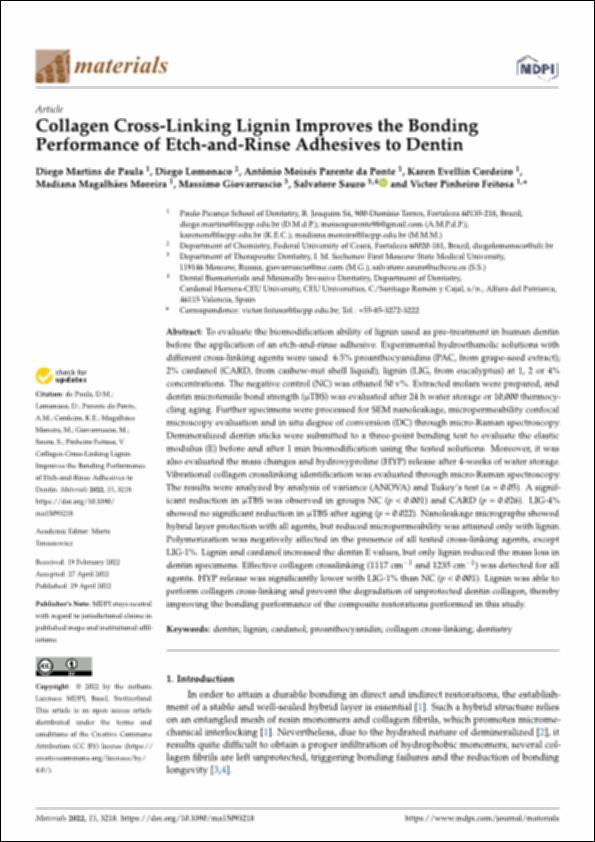Por favor, use este identificador para citar o enlazar este ítem:
http://hdl.handle.net/10637/14360Collagen cross-linking lignin improves the bonding performance of etch-and-rinse adhesives to dentin
| Título : | Collagen cross-linking lignin improves the bonding performance of etch-and-rinse adhesives to dentin |
| Autor : | Paula, Diego M. de Lomonaco, Diego Parente da Ponte, Antonio Moisés Cordeiro, Karen Evellin Moreira, Madiana Magalhaes Giovarruscio, Massimo Sauro, Salvatore. Feitosa, Victor Pinheiro |
| Materias: | Dental materials.; Materiales dentales.; Materiales biomédicos.; Dentina.; Dental adhesives.; Adhesivos dentales.; Dentin.; Biomedical materials. |
| Editorial : | MDPI |
| Citación : | de Paula, D. M., Lomonaco, D., Parente da Ponte, A. M., Cordeiro, K. E., Magalhães Moreira, M., Giovarruscio, M., Sauro, S., & Pinheiro Feitosa, V. (2022). Collagen cross-linking lignin improves the bonding performance of etch-and-rinse adhesives to dentin. Materials, vol. 15, i. 9 (29 apr.), art. 3218. DOI: https://doi.org/10.3390/ma15093218 |
| Resumen : | To evaluate the biomodification ability of lignin used as pre-treatment in human dentin before the application of an etch-and-rinse adhesive. Experimental hydroethanolic solutions with different cross-linking agents were used: 6.5% proanthocyanidins (PAC, from grape-seed extract); 2% cardanol (CARD, from cashew-nut shell liquid); lignin (LIG, from eucalyptus) at 1, 2 or 4% concentrations. The negative control (NC) was ethanol 50 v%. Extracted molars were prepared, and dentin microtensile bond strength ( TBS) was evaluated after 24 h water storage or 10,000 thermocycling aging. Further specimens were processed for SEM nanoleakage, micropermeability confocal microscopy evaluation and in situ degree of conversion (DC) through micro-Raman spectroscopy. Demineralized dentin sticks were submitted to a three-point bending test to evaluate the elastic modulus (E) before and after 1 min biomodification using the tested solutions. Moreover, it was also evaluated the mass changes and hydroxyproline (HYP) release after 4-weeks of water storage. Vibrational collagen crosslinking identification was evaluated through micro-Raman spectroscopy. The results were analyzed by analysis of variance (ANOVA) and Tukey’s test ( = 0.05). A significant reduction in TBS was observed in groups NC (p < 0.001) and CARD (p = 0.026). LIG-4% showed no significant reduction in TBS after aging (p = 0.022). Nanoleakage micrographs showed hybrid layer protection with all agents, but reduced micropermeability was attained only with lignin. Polymerization was negatively affected in the presence of all tested cross-linking agents, except LIG-1%. Lignin and cardanol increased the dentin E values, but only lignin reduced the mass loss in dentin specimens. Effective collagen crosslinking (1117 cm1 and 1235 cm1) was detected for all agents. HYP release was significantly lower with LIG-1% than NC (p < 0.001). Lignin was able to perform collagen cross-linking and prevent the degradation of unprotected dentin collagen, thereby improving the bonding performance of the composite restorations performed in this study. |
| Descripción : | Este artículo se encuentra disponible en la siguiente URL: https://www.mdpi.com/1996-1944/15/9/3218 Este artículo de investigación pertenece al número especial "Biomaterials in Conservative Dentistry". |
| URI : | http://hdl.handle.net/10637/14360 |
| Derechos: | http://creativecommons.org/licenses/by/4.0/deed.es |
| ISSN : | 1996-1944 (Electrónico) |
| Idioma: | es |
| Fecha de publicación : | 29-abr-2022 |
| Centro : | Universidad Cardenal Herrera-CEU |
| Aparece en las colecciones: | Dpto. Odontología |
Los ítems de DSpace están protegidos por copyright, con todos los derechos reservados, a menos que se indique lo contrario.


